Jell-O Salads
Americans have always had a fondness for Jell-O but the Jell-O “salad”? It’s a whole different ball game, and pretty disgusting in retrospect. The mixture of savoury ingredients suspended in gelatin did not, as you might expect, cause people to push their plates away in disgust.
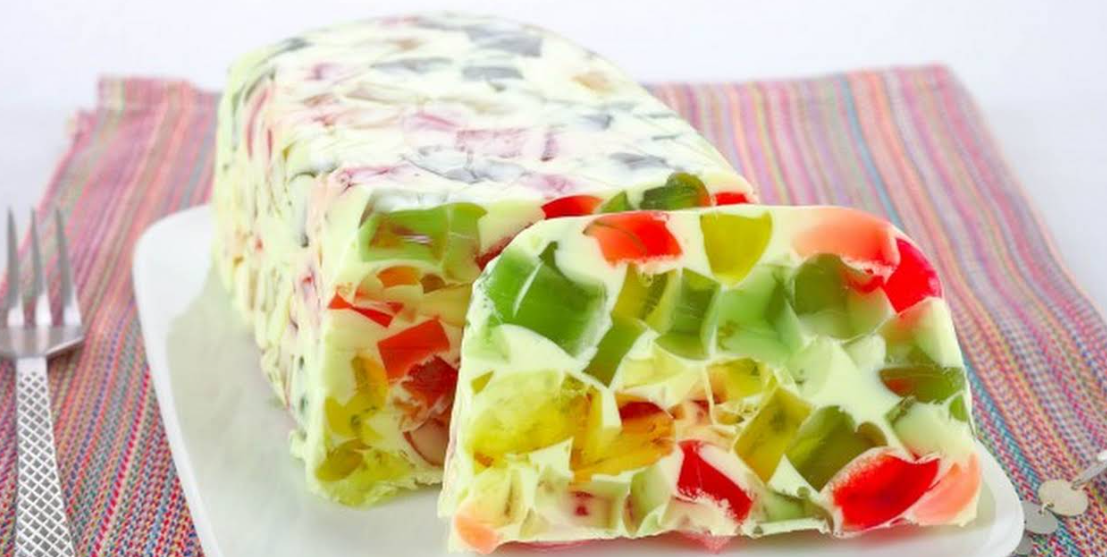
Home cooks really took a shine to Jell-O salads, including aspic, salmon, and even cheese within the gelatin confines. Others played around with shapes, making doughnuts and loaves with the stuff. With the rise of nutritional information, the Jell-O salad was cast aside.
Hamburger Helper
Preparing a meal for the whole family after a day at work was proving tough for some parents and home cooks in the 1970s. Thank God for the invention of the Hamburger Helper in 1971, which quickly rose to prominence thanks to its convenience.
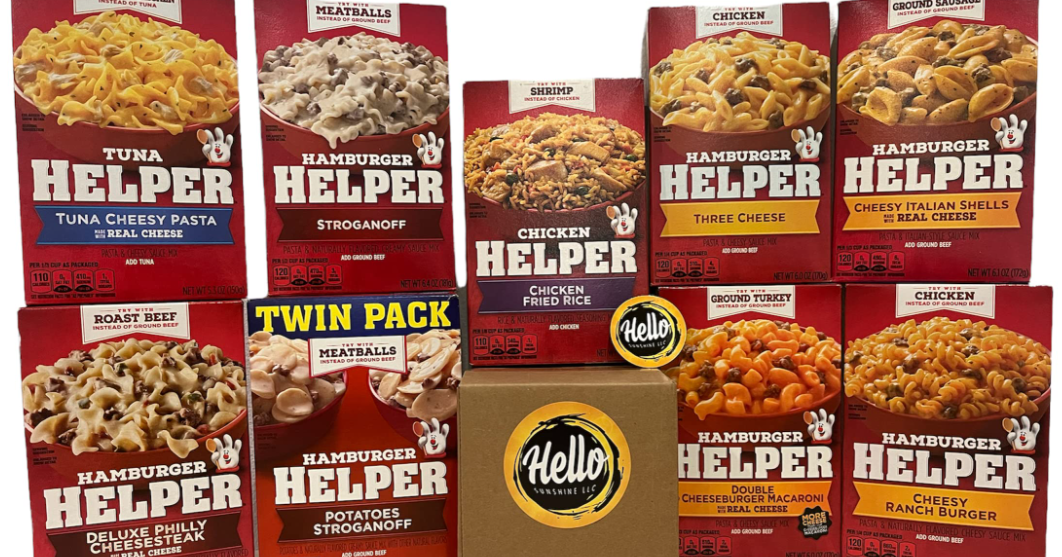
Each box came with dried pasta and packets of powdered sauce and seasonings and for a while, American families couldn’t get enough. Eventually, the likes of the Tuna Helper and Chicken Helper hit the shelves, though only the OG Hamburger Helper remains popular today.
Grins & Smiles & Giggles & Laughs
Released in 1976, Grins & Smiles & Giggles & Laughs was a Ralston cereal brand special. The lore was that Cecil, the robot figure on the box, would produce this cereal whenever someone made him laugh, or, more accurately: grin, smile, giggle or laugh.
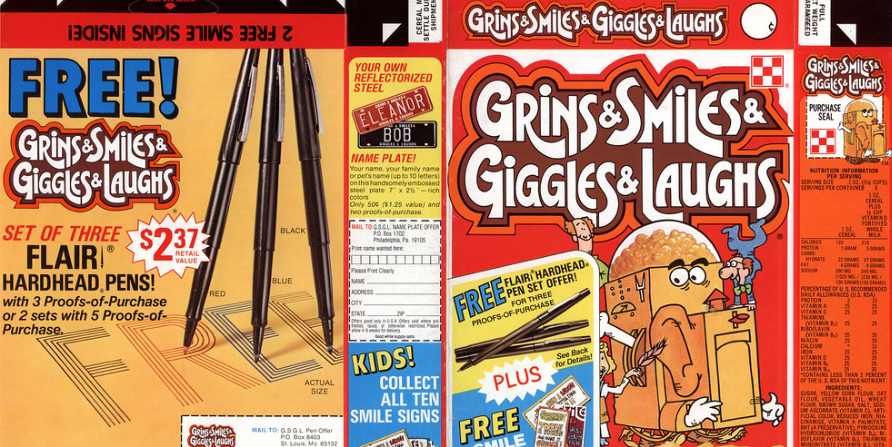
Grins & Smiles & Giggles & Laughs were known for putting prizes within each box such as joke and paint books, often with paint included. At 72 cents a box, this cereal was a steal but unfortunately, it didn’t stand the test of time. They were discontinued after a year.
Koogle
Introduced by Kraft in 1971, Koogle was a peanut butter spread in the same vein as Nutella. The goo’s unique selling point was that it didn’t make your mouth stick together the way regular peanut butter did. It came in four flavours: chocolate, banana, vanilla, and cinnamon.
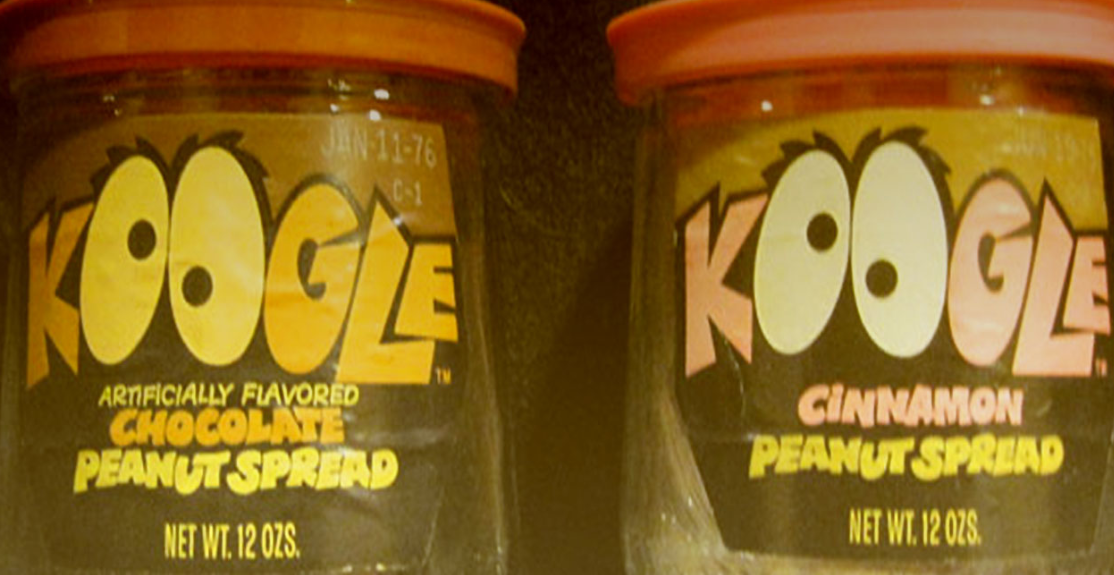
With the help of its alien mascot shaped like a tub of peanut butter with four eyeballs, messy blue hair, and a giant K insignia, Koogle was a huge success with kids. Unfortunately, it was axed towards the end of the 1970s, marking the end of a tasty era.
Mug-O-Lunch
Instant noodles were flying off the shelves leaving Betty Crocker no choice but to launch their own version in 1977. It was called Mug-O-Lunch and it came in four flavours: Macaroni & Cheese, Beef Noodle, Chicken Noodle, and Spaghetti. Simply add boiling water!
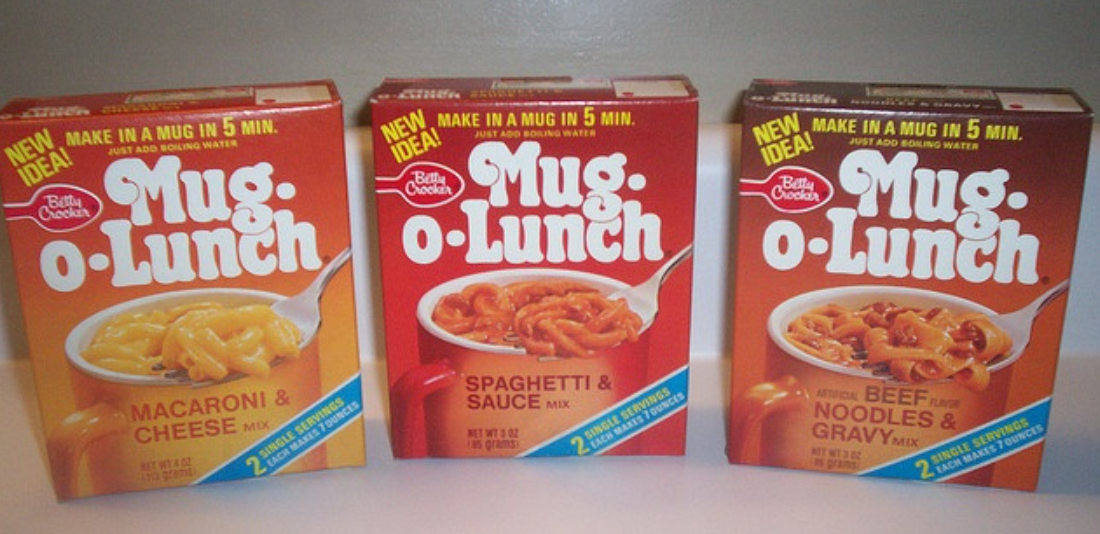
Portions weren’t great, which spelled the beginning of the end for the Mug-O-Lunch. While they would satiate a small child, adults required at least three of these things for it to count as a complete meal, and who wants to pour boiling water three times? At that point, you may as well just make some real mac and cheese.
Sir Grapefellow cereal
Released by General Mills around 1972, Sir Grapefellow cereal flew too close to the sun, but what a dazzling flight it enjoyed. This grape-flavoured cereal came with actual marshmallows. Marshmallows for breakfast! Children had never had it so good.
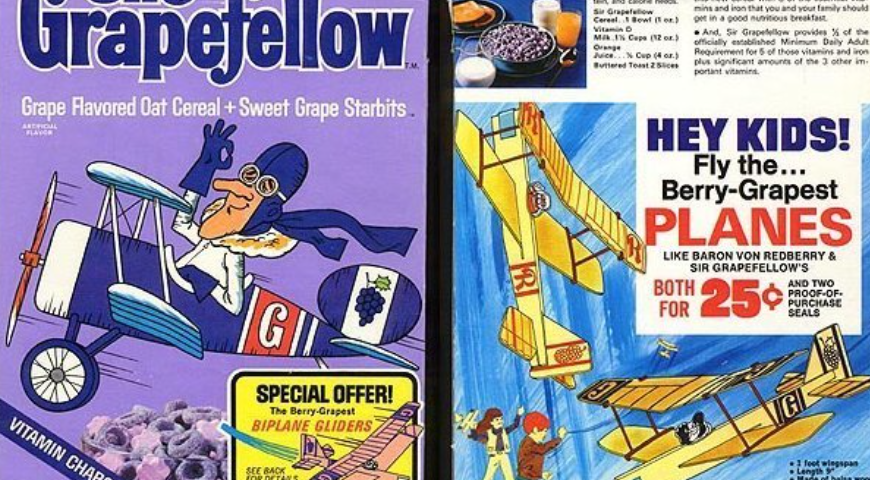
Unfortunately, Sir Grapefellow tasted like trash. Saturated with a grape flavouring that resembled cough medicine and with an overpoweringly fake and strong grape odour, it was only a matter of time before this cereal flew off the shelves for the final time.
Snack Pack
In 1968, Hunt’s released the Snack Pack in eight wonderful flavours: banana, chocolate, vanilla, and butterscotch. A pudding for your kids immediately, with no fuss or mess. And they were portable? These things were a Godsend for any parents in the 1970s.
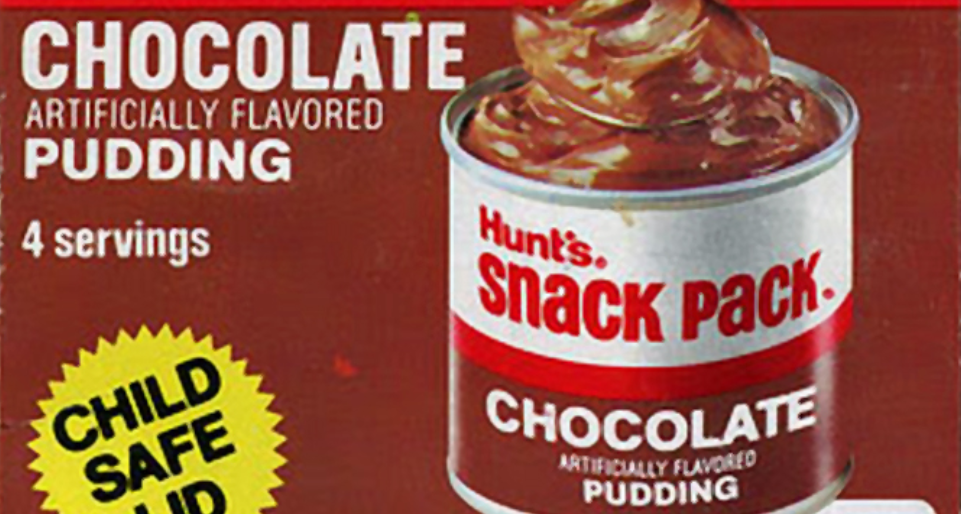
The trouble was that the sharp metal lids on the cans were incredibly dangerous. Within a few years, they were replaced with a more child-friendly can. This was then replaced by the Snack Pack Jack with his pudding can-shaped cap. By 1984, these became the norm.
Tiramisu
Tiramisu is a pretty old dessert, but its modern incarnation has been attributed to pastry chef Robert Linguanotto of Le Beccherie in Treviso, Italy. In 1968, he mixed espresso, mascarpone, eggs, and Marsala-soaked ladyfingers, changing the world in the process.
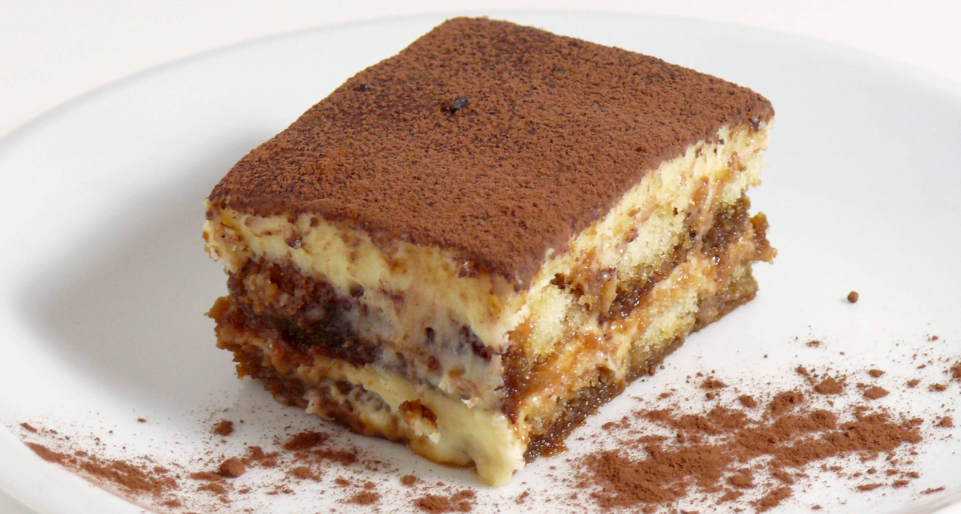
Tiramusi took the 1970s by storm. It remains popular today, though the experience will vary wildly from restaurant to restaurant. You’re more likely to get a cheapened version using spongecakes and cheap alcohol in, say, Olive Garden, and the majority of 1970s homebakers weren’t aiming for five-star cuisine.
Zucchini bread
Have you ever grown zucchini? Chances are, if you have, that you’d found yourself with an abundance of the vegetable after a certain point of the season. What do you do with it all? Well, you could make zucchini bread like everyone else in the 1970s.
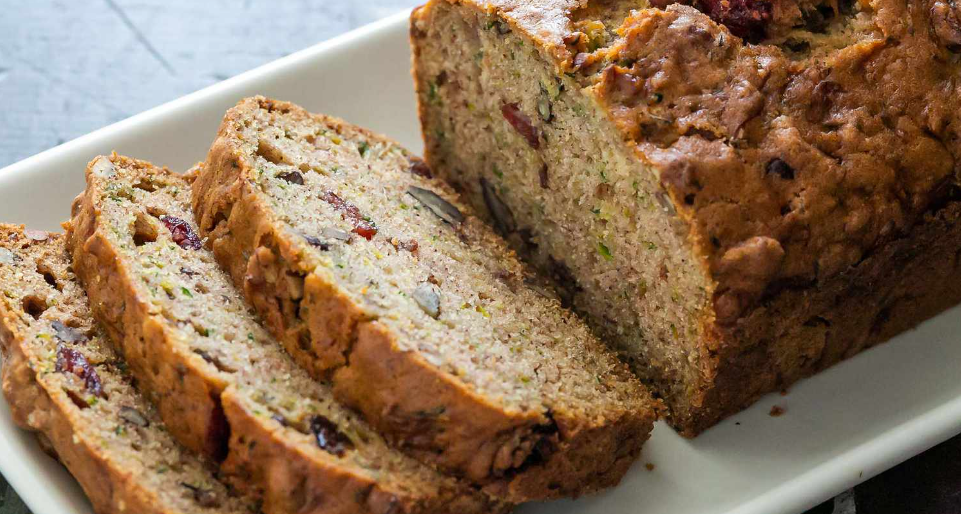
Thanks to its subtle taste, zucchini was right at home in the cake, helping not only keep it moist but also healthy. It and carrot cake and banana bread were all considered breakfast and after-school snacks that you could eat with a clear conscious.
Space food sticks
Manufactured by Pillsbury in the US, Space Food Sticks were actually developed as a snack for the Apollo Space Mission, meeting government requirements for adequate nutrition and everything. The downside was they tasted like straight up dog food.
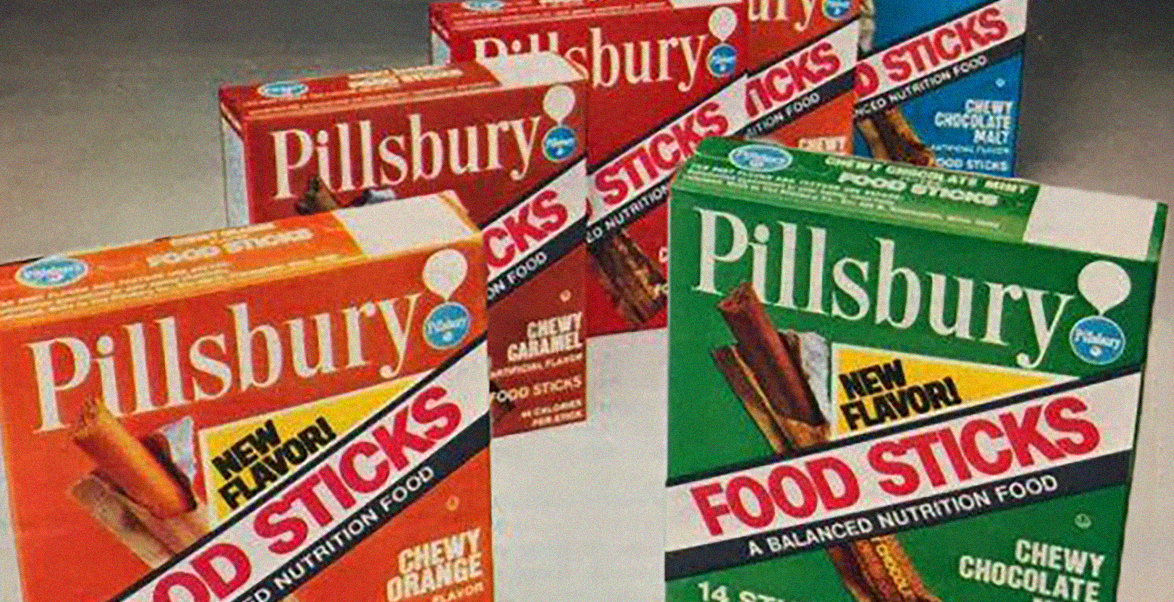
Pillsbury went back to the drawing board, added extra flavour, and released them again in 1971 after Aldrin and Armstrong walked on the moon. White Wings began selling the sticks in space-age foil, adding to the astronaut lore and making them a huge hit.
Fondue
Fondue remains popular at ski resorts and certain restaurants but in the 1970s, it became a bit of a craze. What was not to like about a big bowl of melted cheese served with fresh bread? Nothing, that’s what. This communal pot brought people together, literally.
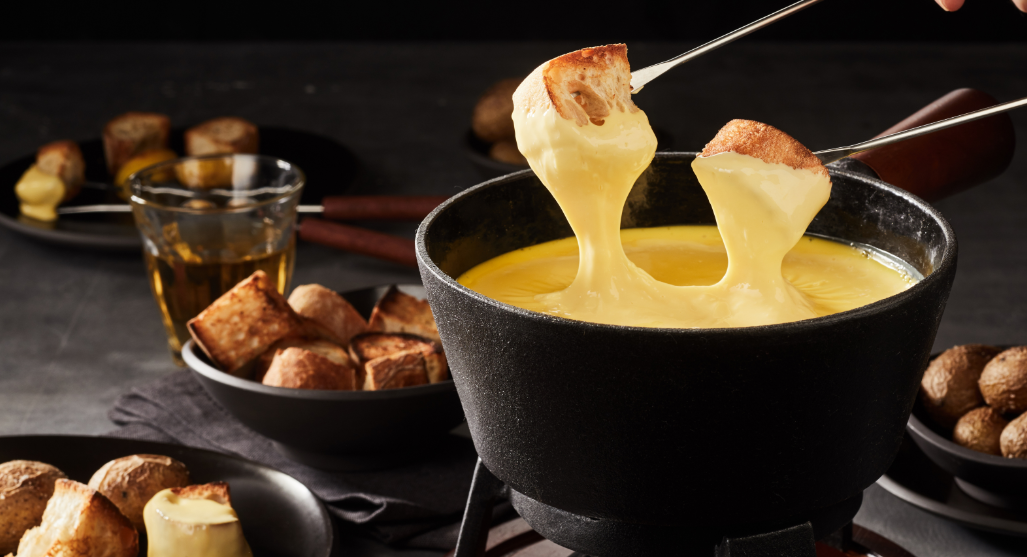
Fondue had been popular in Switzerland since the early 1700s but struck a chord with Americans after it was promoted by the Swiss Pavilion’s Alpine restaurant at the 1964 World Fair in New York. If you lived in a colder state during this time, you probably had fondue.
Pasta Primavera
Pasta primavera has a fancy name but it’s quite a simple dish of pasta and fresh vegetables. It grew popular in the 1970s after appearing on the menu at Le Cirque, a New York restaurant helmed by the head chef Sirio Maccioni.
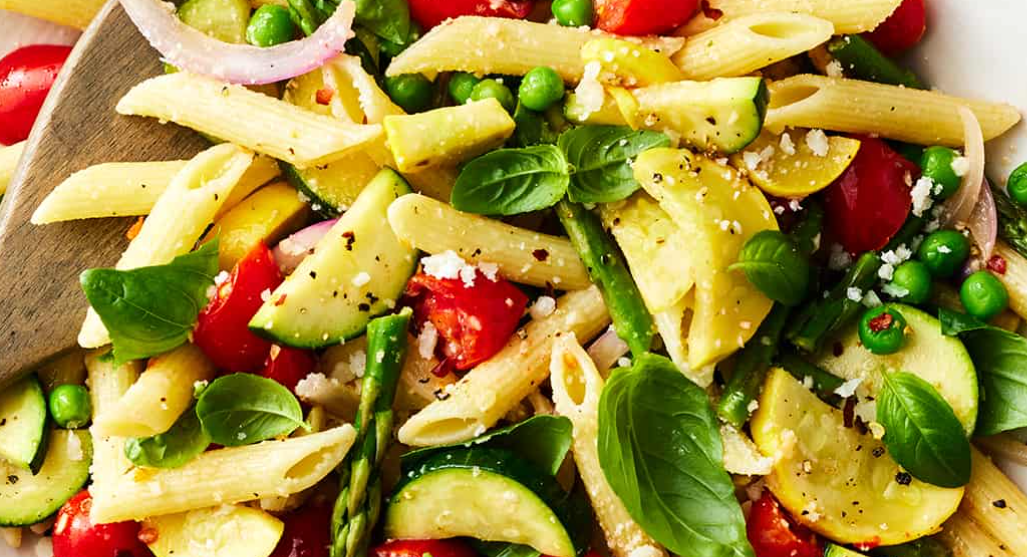
The pasta, usually served with flat tagliatelle noodles, is tossed in butter, cream, and cheese before being combined with fresh veg. It caused quite a stir in Manhattan when it was conceived of, and soon after families began making this easy dish in the comfort of their own home.
Fajitas
You can’t move for fajitas today but back in the 1970s, they weren’t anywhere near as popular as they went on to become. This Tex-Mex cuisine really took hold in the mid to late 70s as diners were happier to broaden their horizons and try new flavors and cuts of meat.
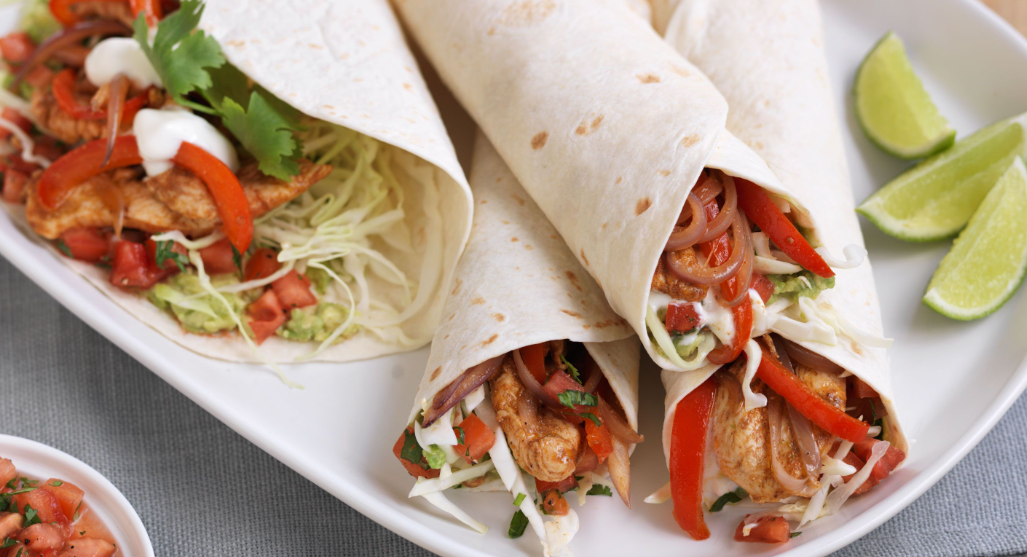
Fajitas were the perfect gateway meal into a broader horizon of flavours. Strips of grilled beef or chicken, cooked with bell peppers and onions served on soft flour tortillas with sour cream, salsa, and guacamole. What’s not to like? The craze continued well into the 80s and 90s.
Black Forest Torte
Black Forest Torte had existed in Germany for decades before it hit the US in the 1970s, but when it did, oh boy! Let’s just say that fewer cakes have gone down in food history as well. It’s basically a chocolate cake layered with whipped cream and covered in Maraschino cherries and chocolate shavings.
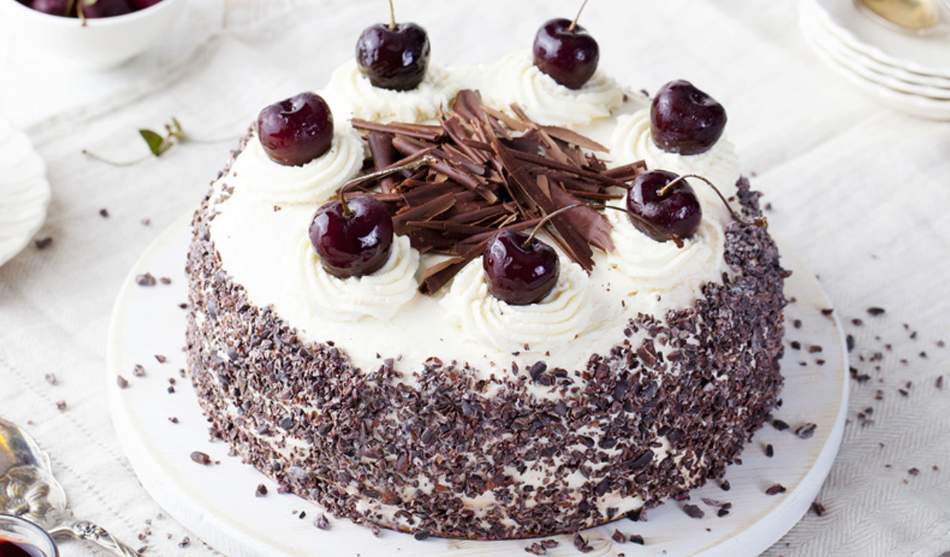
The fun didn’t end there, either. The cake was then doused in Kirsh, a clear liqueur made from sour cherries. Making one of these back in the day would get everyone running to the kitchen. Today, you can find them ready-made in most grocery stores.
Cheese Balls and Logs
There were a lot of fads from the 1970s that are unexplainable today and cheese balls were one of the best. The idea of forming cheeses into balls or logs by rolling them in a tight covering of plastic wrap and covering them in toppings was all the rage during that dizzy decade.
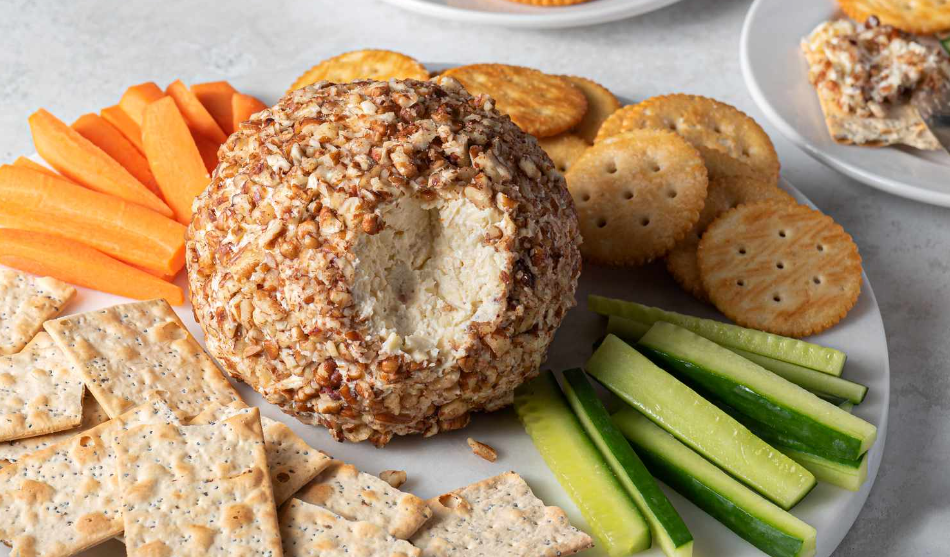
Most cheese roll recipes called for the use of soft cheeses, which were then meshed together and formed into a funny or whimsical shape. The ball or log would then be rolled in black pepper, herbs, and possibly even nuts. Nuts! Served with crackers, it didn’t get better than this.
Carrot Cake
America knew she had a weight problem even in the 1970s, and so introduced a dessert that could be tasty and “healthy” at the same time. The result was carrot cake. Of course, this wasn’t healthy at all, thanks to all the sugar plied into it and the cream cheese icing.
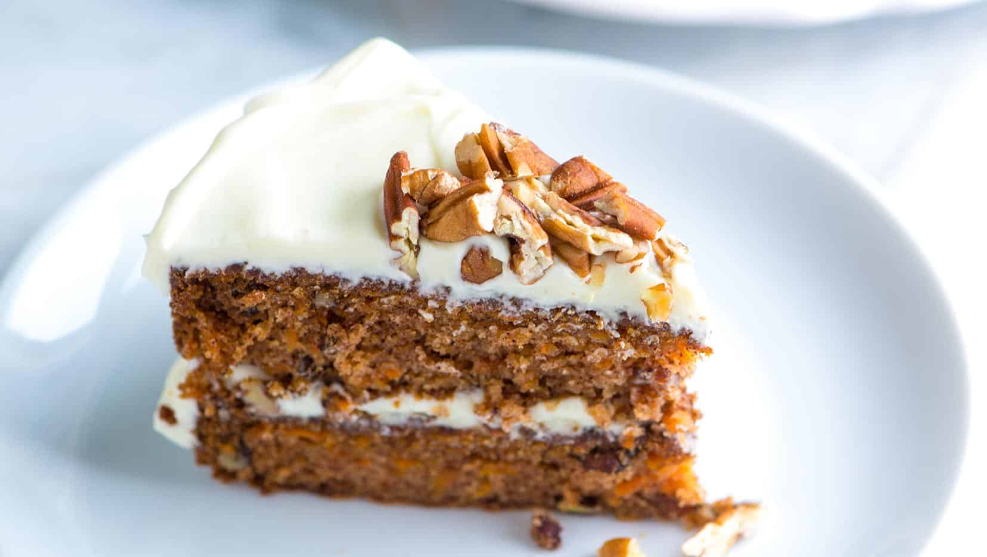
The carrot cake was actually first invented way back in the late 16th century. Which country it originates from is still up for debate. Some say England, some say France, some even say Switzerland. All we know is carrot cake was a big deal in the 1970s.
Hawaiian Cuisine
This wasn’t a single dish but rather a single fruit. When the pineapple appeared on plates in the 1970s, mainland Americans approached it like the monolith in 2001: A Space Odyssey. What is this? What does it do? Is it a threat to my existence?
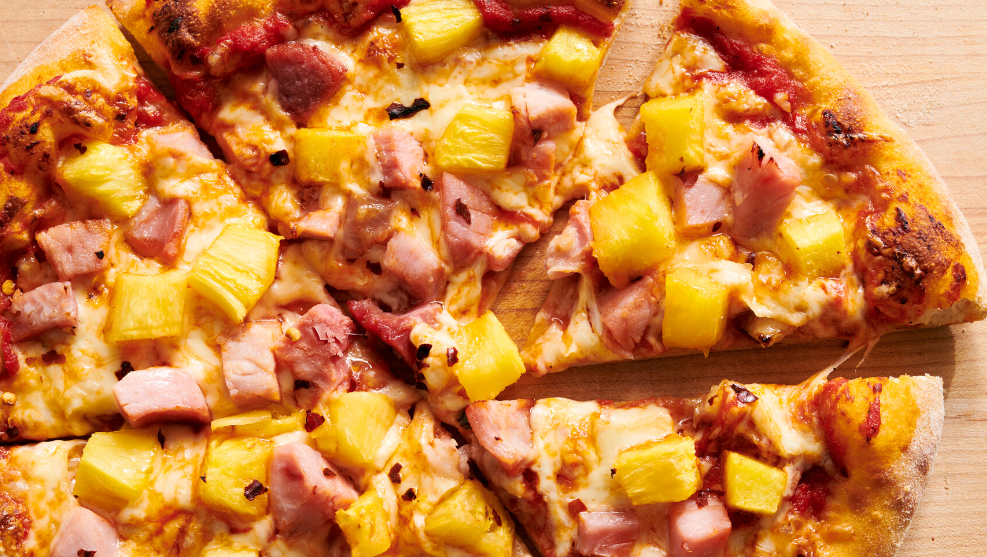
No, it wasn’t. It was just a nice, sweet addition to a lot of meals, including chicken and most famously, pizza. That’s right. The 1970s may have given us Martin Scorsese and disco, but it also gave us the dreaded, polarizing Hawaiian pizza.
Toastwiches
Toast makes everyone happy, and it is one of the most unanimously beloved foods besides maybe bread itself. It is one of the very few snacks to have transcended multiple generations. Toastwiches were no different back in the 1970s. In an era of fancy pineapple dishes and fondue, these were a breath of fresh air.
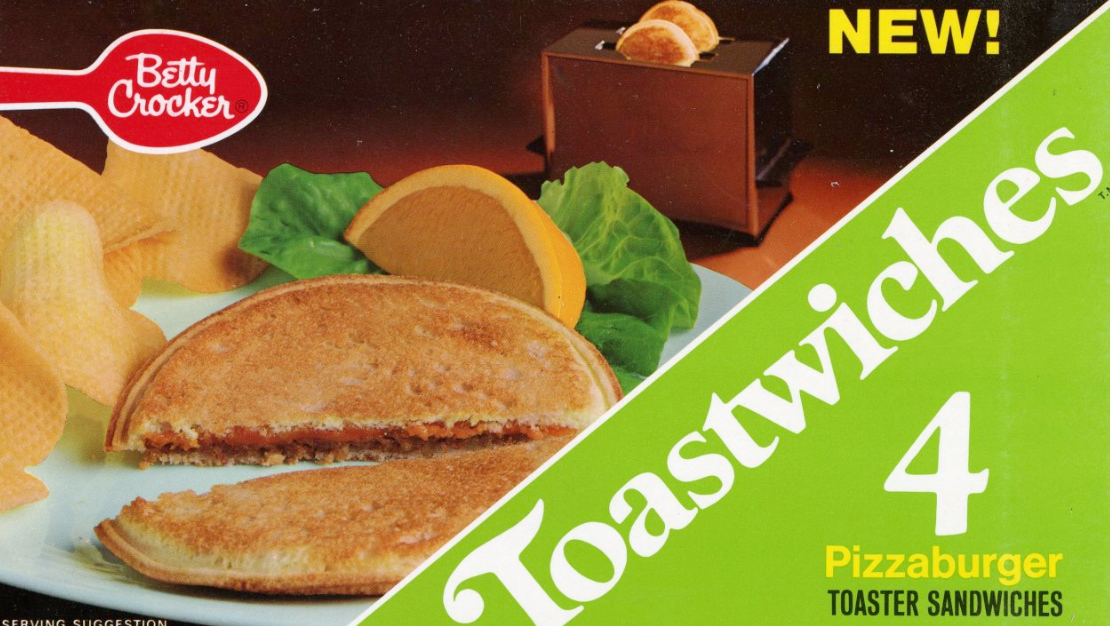
Examples of this came in the form of Betty Crocker’s sausage and maple syrup-flavored French Toastwiches, grilled cheese Toastwiches, and Pizzaburger Toastwiches – which were not the best, admittedly. You can find these things in the frozen aisle of any grocery store to this day.
Sloppy Joes
Sloppy Joe’s are folkloric at this point. Still popular, though maybe not as much as they once were, these indulgent buns take a lot of Americans back to their childhoods; to a time when they could eat any old thing and not have to worry about love handles.
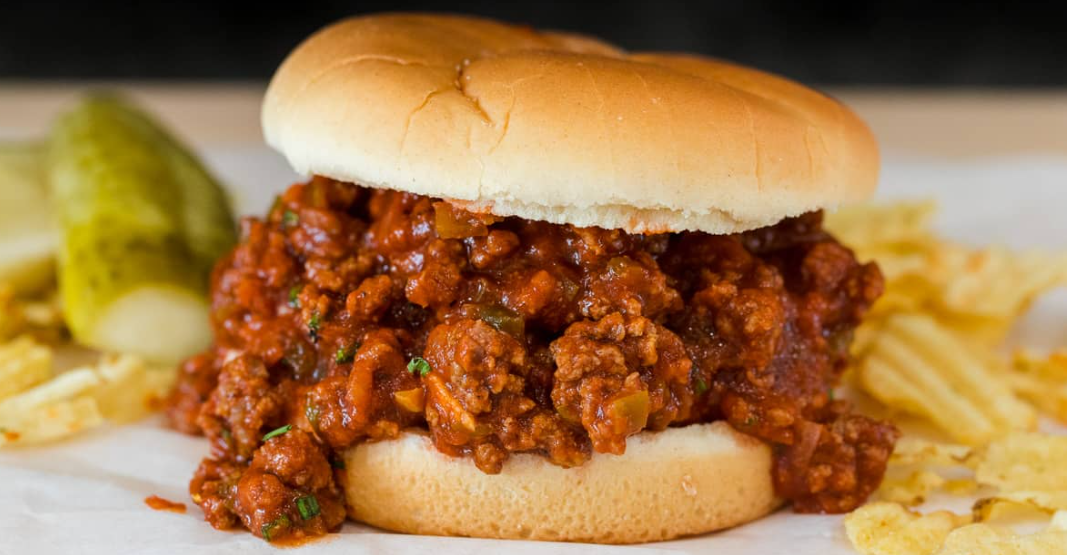
Hunt’s Manwich Original Sloppy Joe Sauce was invented at the tail-end of the 1960s and became a smash throughout the 1970s. Tomato sauce mixed with minced beef and piled into a hamburger bun? A complete doozy. No family household stood a chance.
Campbell’s Chunky Soup
You know Campbell’s Soup. You’ve either had it on your shelves or you’ve seen it repeated a hundred times over on the walls of an art gallery. Andy Warhol may have put Campbell’s Tomato Soup on the map in the 1960s, but the Chunky Soup was all 70s.
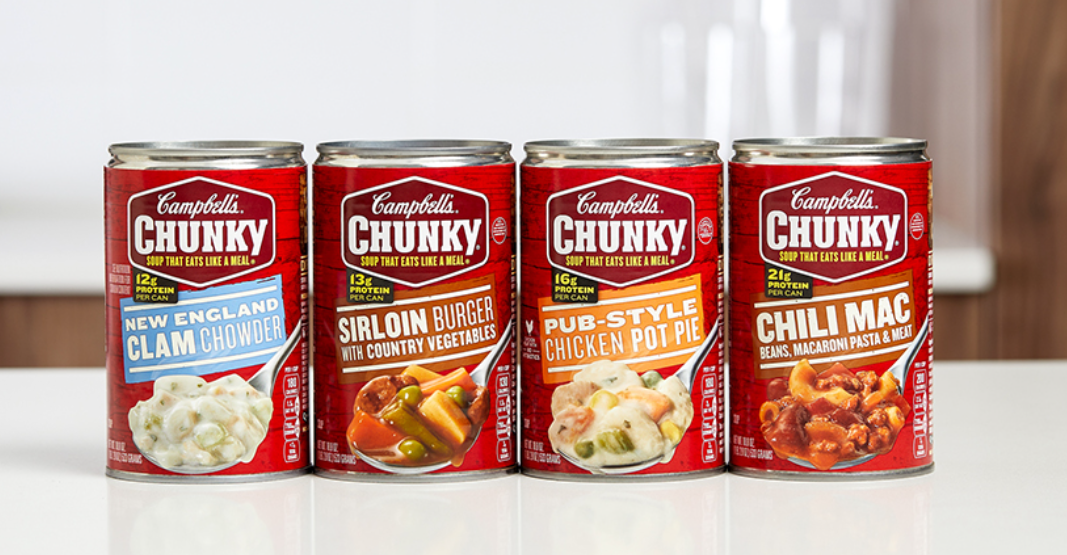
Debuting in 1971, Campbell’s Chunky Soup was marketed as a meal in a can, or “soup so chunky you’ll be tempted to eat it with a fork”, and it kind of was and you kind of were. Customers had the option of chunky chicken, beef, turkey, or vegetable.
Cup Noodles
It’s impossible to imagine a world without instant noodles. Go to any store and there are entire aisles devoted to them, with an array of different flavours on offer. But prior to the mid-20th century, noodles were simply a traditional Asian staple.
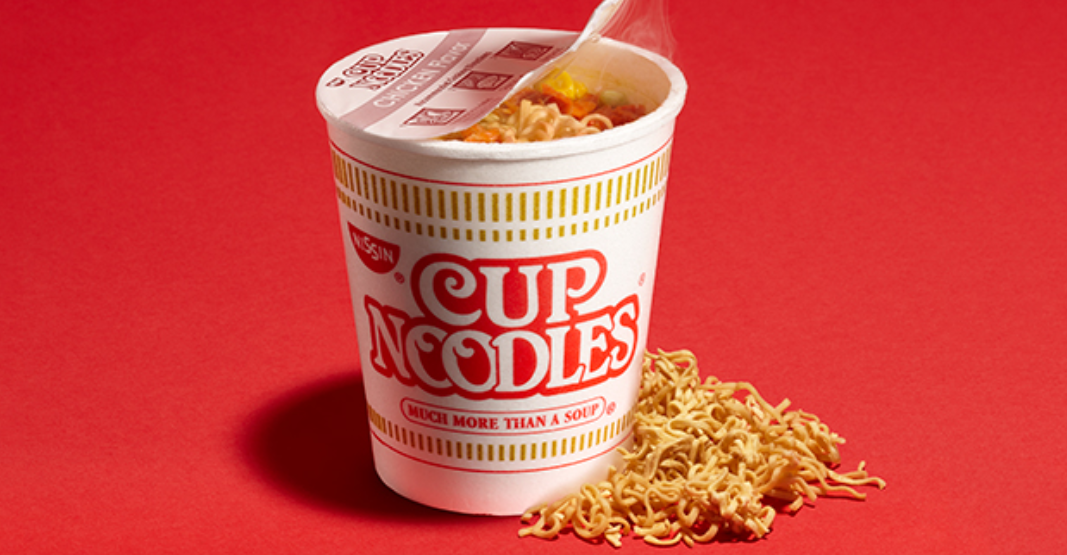
Enter Cup Noodles. They were invented in Japan in the 1950s and travelled across the Pacific to the States in 1971, proving a huge success. Cup Noodles have sold over 40 billion cups since their debut. That’s over five times more than the population of the planet.
Alpen
Americans go crazy for a good bowl of cereal but they’re usually in the danger zone health-wise, thanks to high-sugar levels. Think Lucky Charms, Cinnamon Toast Crunch, and Frosted Flakes – these are some very tasty but nevertheless harmful foods to be eating every day.
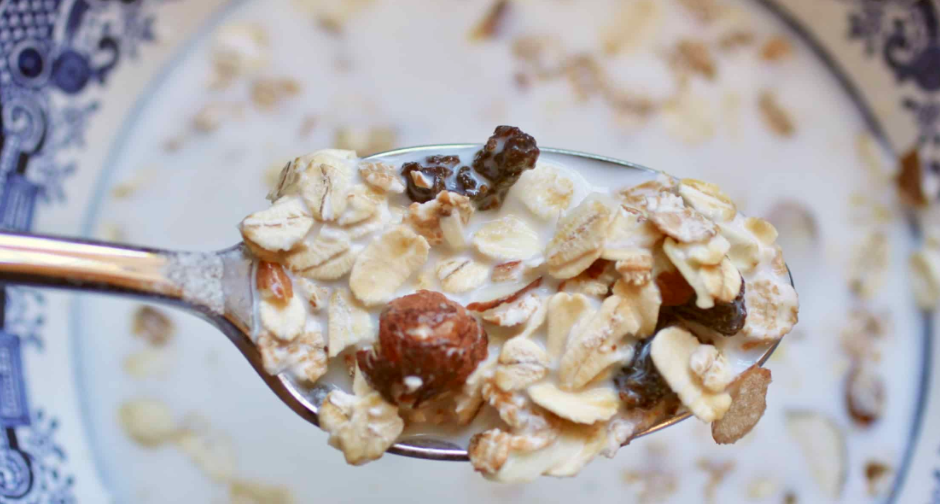
When Muesli entered the chat, things changed. Alpen cereal was created by one of Weetabix’s board members after he tried Swiss muesli on a family ski trip. Launched in 1971, Alpen was a revolution in the health-conscious 1970s and remains popular today.
Sparkling Water
Who wants plain old tap water? Not the Americans. Not in the 1970s they didn’t. For better or worse, this decade saw the birth of sparkling water and we’ve been sipping it ever since. None is more popular these days than the Perrier brand, which has been a mainstay for decades.
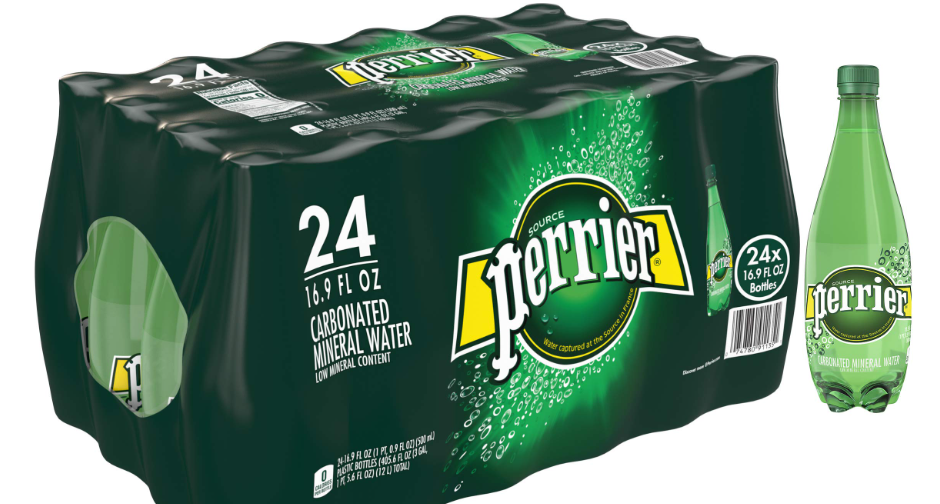
Drawn from a spring in southern France, Perrier was rolled out across the US in the middle of the 70s. It was already a huge hit in France but the green glass bottled water became a status symbol for a lot of well-to-do Americans, or aspiring members of the middle class.
California rolls
Today, sushi is one of America’s greatest multicultural success stories. But did you know it was first picked up in the States around the turn of the 1970s? Of course, it wasn’t traditional sushi like we enjoy today and more closer to a middle-class American’s idea of sushi.
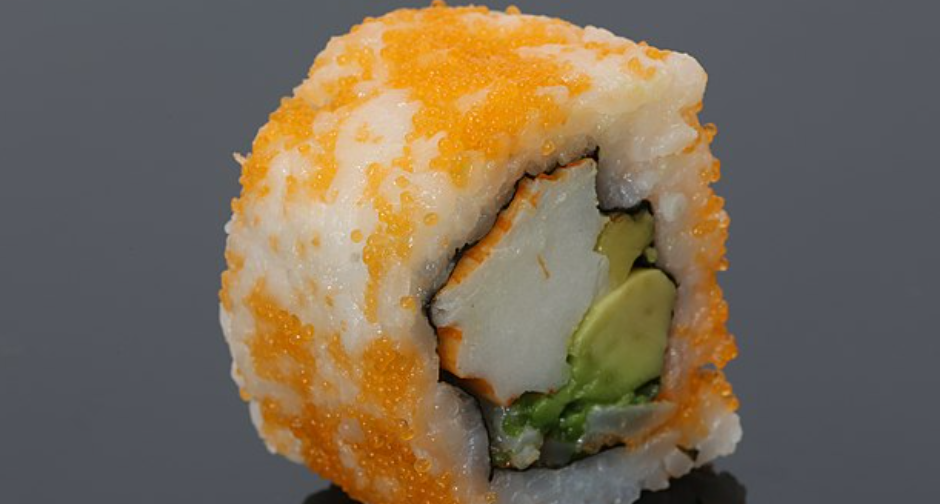
The California Roll is made in a normal maki roll with nori or seaweed, before being filled with such ingredients as cucumber, crab, and avocado. Lots of chefs have claimed to have invented “American sushi” but the honour likely goes to LA restaurant Tokyo Kaikan.
Egg McMuffin
This one’s not so weird nowadays when, for millions, a regular morning commute isn’t complete without picking up an Egg McMuffin or two. But in the 60s and 70s, McDonald’s was more of an evening option for customers. The idea of a burger first thing? Yuck.
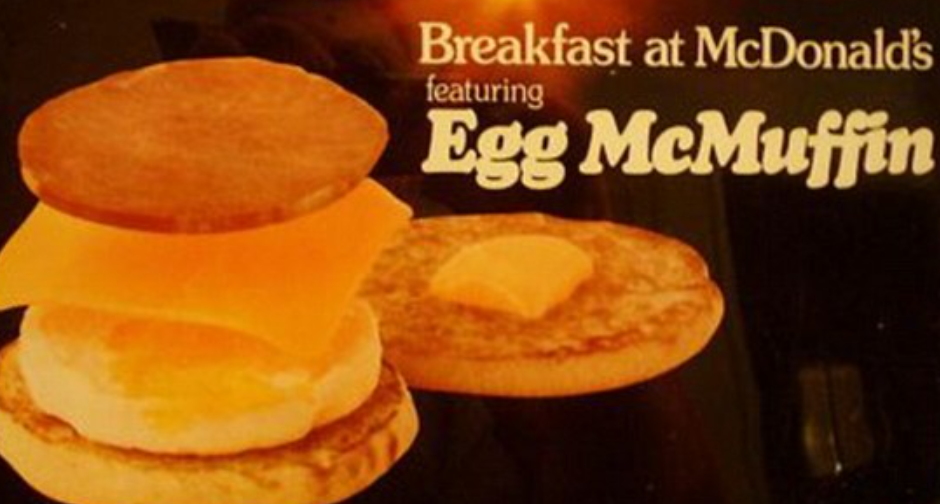
Until 1972, of course, when Maccy D’s dropped the Egg McMuffin and revolutionized the way we view fast food first thing in the morning. This perfectly round fried egg, topped with bacon and American cheese on a toasted English muffin is a classic for a reason, and it’s hard to imagine a cold Monday morning without it.
Snapple
Do you know where one of the, if not the first mention of iced tea ever came from? Naples! As early as 1823, Marguerite Countess of Blessington wrote of drinking a cup of iced tea in the Italian city. Some two hundred years later, we’re all Marguerite!
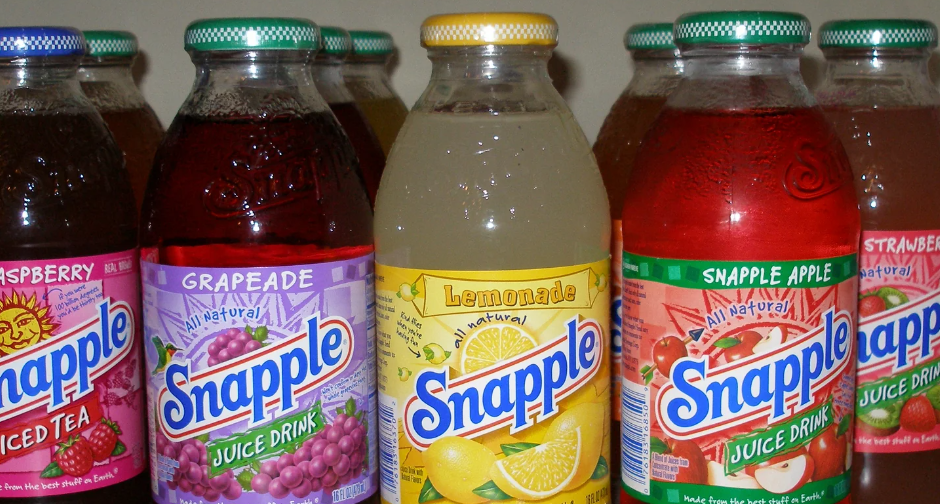
Launched in 1972, Snapple was one of the first iced tea brands to go toe-to-toe with the likes of Big Soda on the topic of health benefits. Snapple was and remains known for some incredible advertising campaigns and the “real facts” inside the bottle caps.
Pops Rocks
No childhood was complete without the experience of going to a shop with your pocket money, buying some new candy that pops in your mouth, walking outside, trying said candy, and then telling all your friends about it as though you’ve just discovered sliced bread.
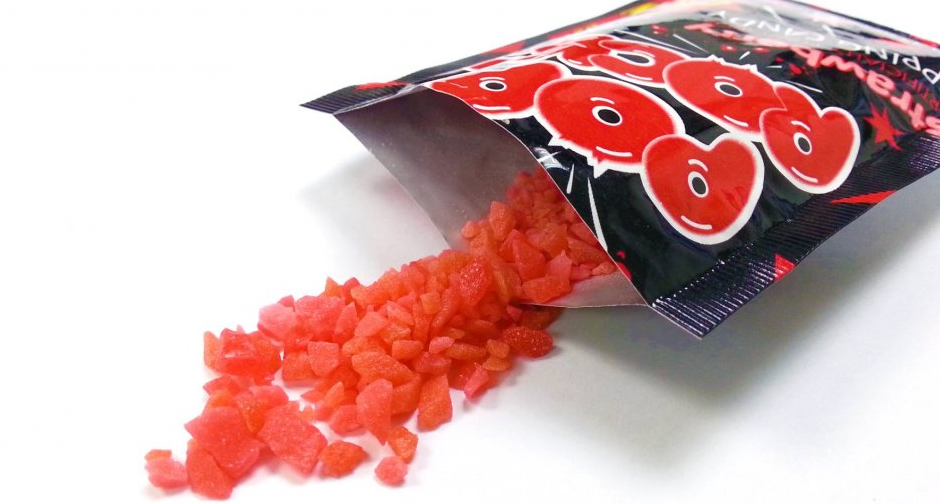
Pop Rocks had this hold on the youth of America when they went on sale in 1975. Kids loved that crackling sound and tingly feel in their mouths. These treats were made by trapping carbon dioxide inside sugar crystals. When you bite into one, the gas escapes the sugar and makes a popping noise.
Golden Grahams
Did you know about half of Americans eat cereal for breakfast every day? Battle Creek in Michigan is even known as the Cereal Capital of the World as it’s home to two of the world’s largest cereal manufacturers, Kellogg’s and Post.
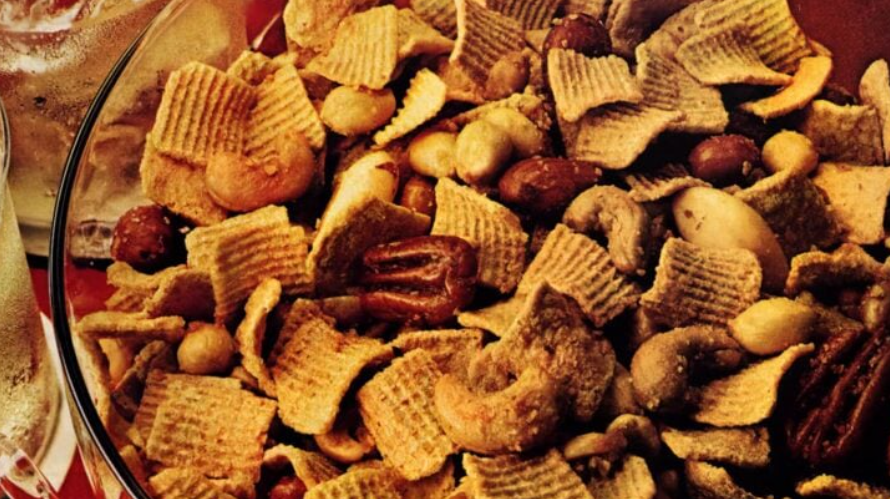
Golden Grahams arguably helped those stats. Released in 1975, they were an instant hit with children and adults. In 1978, Woman’s Day posted an advert that suggested Golden Grahams could be mixed with nuts and eaten as a snack without milk.
Jelly Belly
Boston isn’t just the home of Mark Wahlberg and John F. Kennedy. The Athens of America also invented the humble, yet extremely popular jelly bean back in 1861, when confectioner William Schrafft sent them to soldiers during the American Civil War.
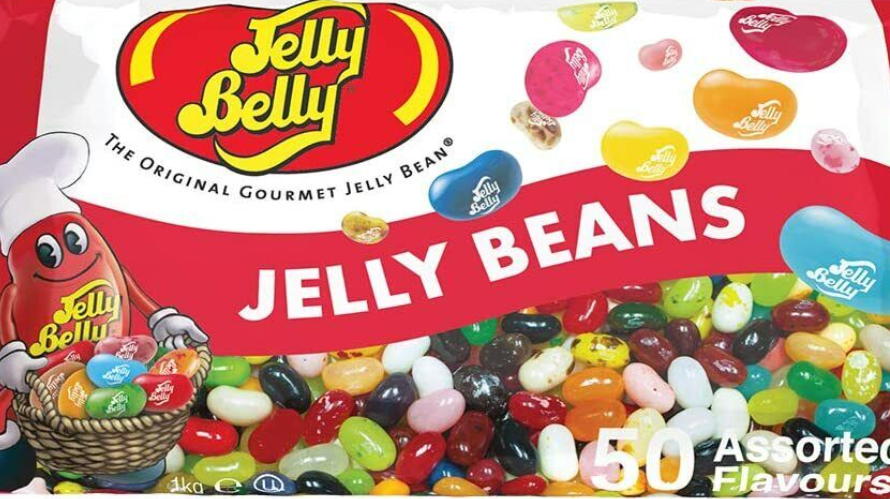
When it comes to branded jelly beans, look no further than Jelly Belly. Introduced in 1976, these beans were made from natural purée, with flavours ranging from grape, green apple, root beer, and cherry. Today, there are more than 50 different kinds.
Mississippi mud pie
Mississippi mud pie is a rich chocolate dessert made with layers of cake, pudding, biscuit, ice cream, whipped cream, and liqueur. Put all that on a cookie crust base and you’re well and truly in business, my friend – especially if you’re living in the 1970s.
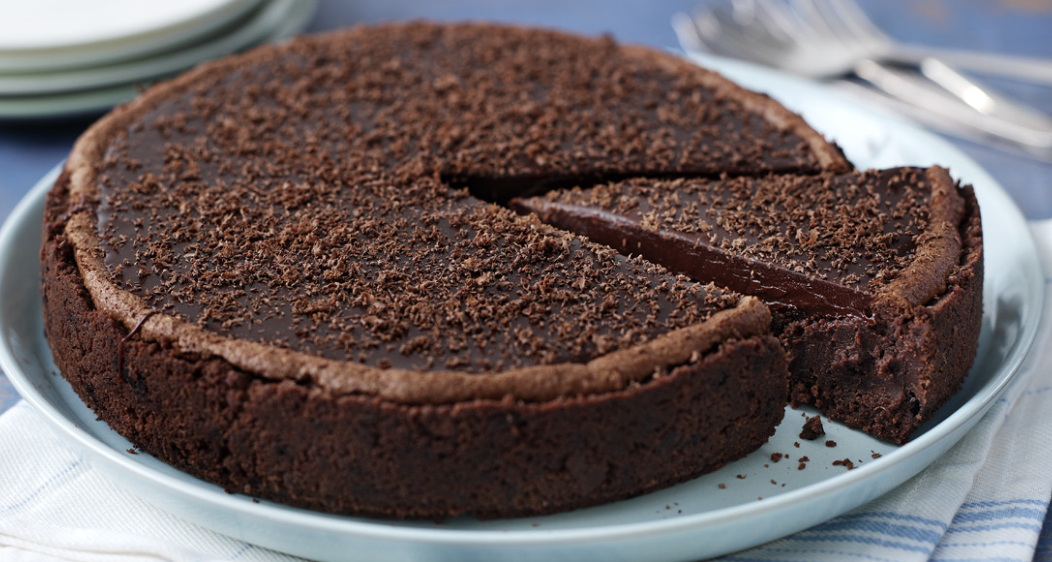
This mud pie was originally linked with the southern states but is now enjoyed throughout the country and beyond. The name itself is derived from the dense cake that resembles, apparently, the banks of the Mississippi River. Hopefully it tastes much better than actual mud!
Granola bars
Granola, then Granula, was invented in New York by Dr James Caleb Jackson at the Jackson Sanitarium in 1863, consisting of sweetened whole grain products crumbled and then baked until crisp. Over 100 years later, the same mixture was turned into bars.
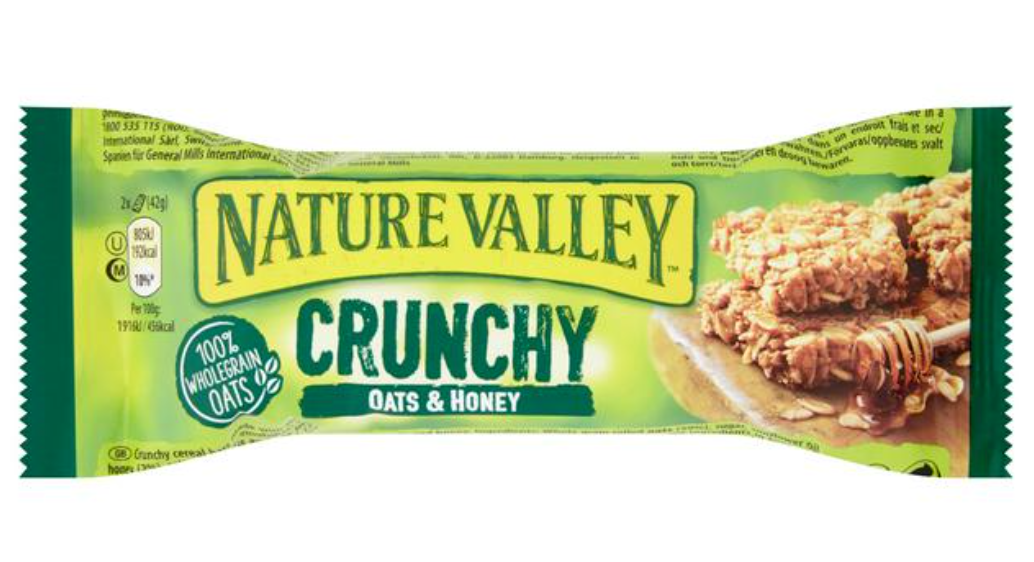
Nature Valley created the first granola bar and they mass-produced the heck out of it. Sitting down and wasting time eating breakfast in your home was suddenly a thing of the past. Customers could now take their breakfast on the go – what an innovation!
Ring Pop
Something seismic happened in 1971. Willy Wonka & the Chocolate Factory was released in cinemas. Kids had always been into candy but this took things to the next level, leading to the movement of interactive candy. The goal was to create something to be experienced as well as enjoyed.
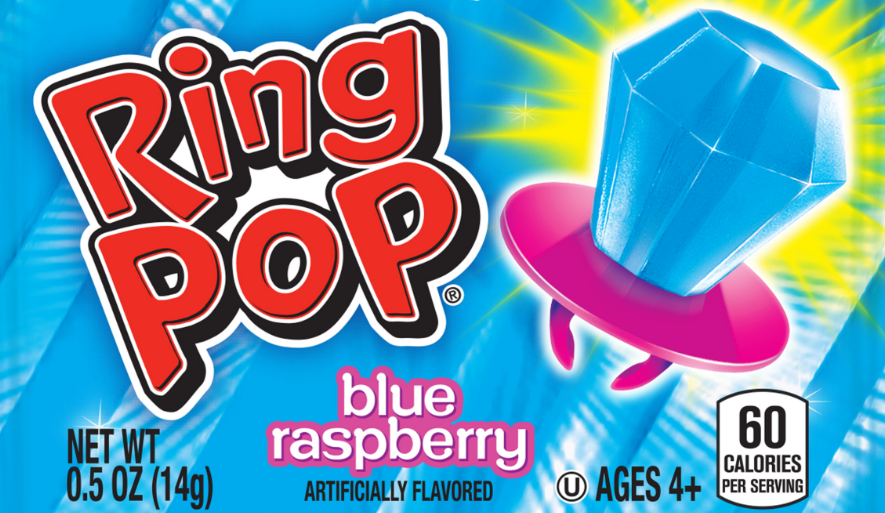
Manufactured and released by Topps, Ring Pops were jewel-shaped candy rings so large that they could actually hurt your hand. The good thing was they lasted for an age so you really got your money’s worth. Ring Pops came in fun flavours like cotton candy and bubblegum.
Frozen yogurt
What did people do before the soft, refreshing joy that is frozen yoghurt? Sit around eating regular, runny yoghurt? Boring! Gross! You really have to thank God for the 1970s sometimes. They delivered so much that we now take for granted.
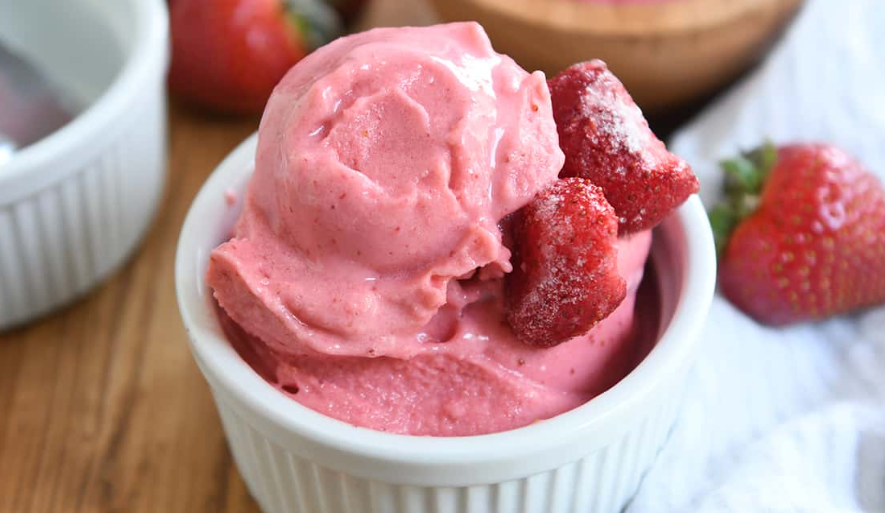
Frozen yoghurt was first created at Hood Dairy in Lynnfield, Massachusetts, and it took a while for the public to react. The first few recipes were a little too tart and similar to normal yoghurt. After a bit of trial and error though, the recipe was perfected, and we’ve never looked back.
Blue Nun
Blue Nun can be used as a punchline these days but for a while there in the 1970s and 80s, it was the talk of the town. David Bowie and Rod Stewart drank this sugary and fruity wine like water. It was to rock n roll what Monster is to MMA, basically.
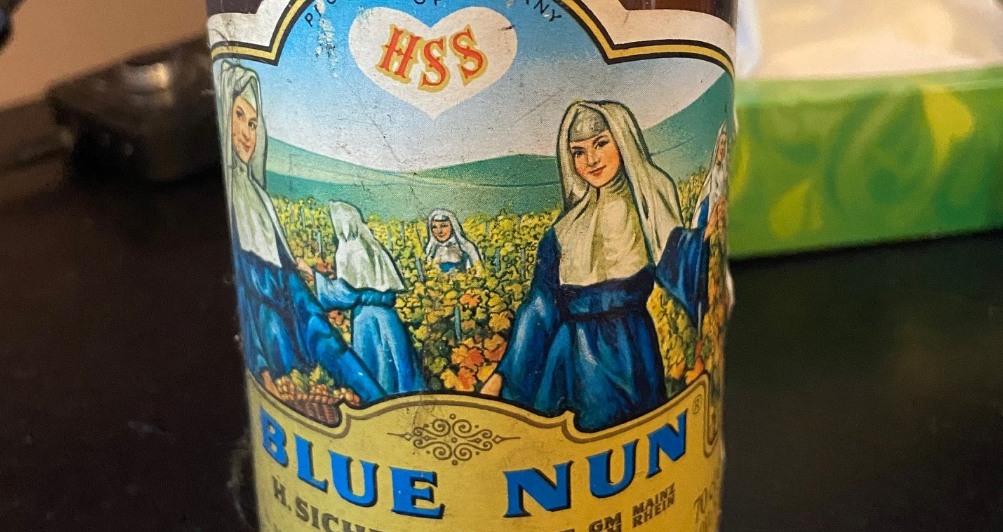
Following the Second World War, this German beverage became insanely popular throughout the UK and the US, probably because it was sold for the same price as some red Bordeaux wines. Blue Nun’s popularity peaked in 1984 when annual sales in the US exceeded 1.25 million cases.
Chicken tikka masala
Don’t go travelling through India looking for a bright orange bowl of chicken tikka masala. This is very much a hybrid invention of multicultural Britain. Emerging from Anglo-Indian kitchens in the 1970s, the chicken is marinated in yoghurt and spices, grilled, and then served in a creamy tomato gravy.
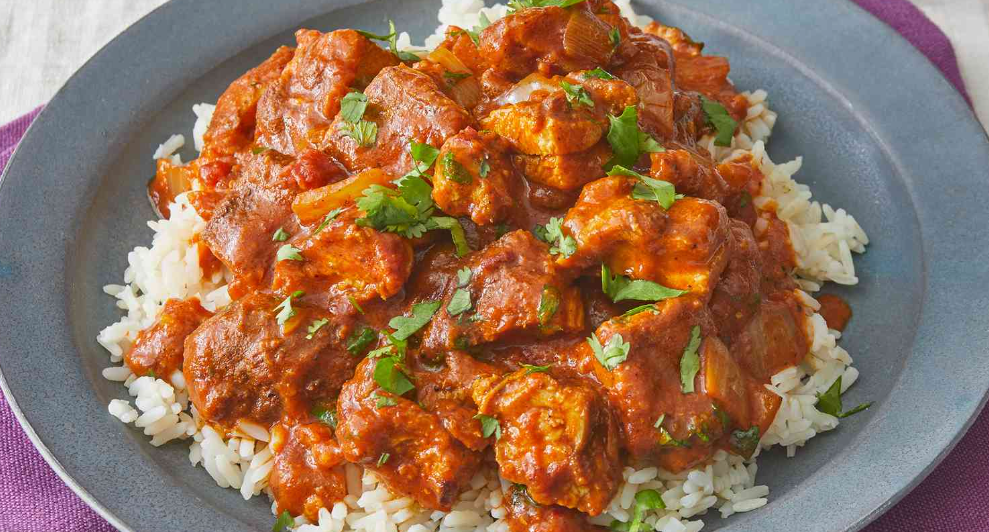
Forget fish and chips or a Sunday roast, chicken tikka masala routinely comes out on top in the lists of the UK’s favourite dishes – and for a good reason. Plus, over in the States, on the likes of New York’s Murray Street, this remains a favourite.
Danish Go-Rounds and Danish Rings
Rolled out by Kellogg’s in 1968, Danish Go-Rounds was inspired by Pop Tarts with their various fruit fillings in a circular pastry. Flavours included strawberry, blueberry, and cinnamon. They were marketed as a fun alternative to traditional Danish pastry.
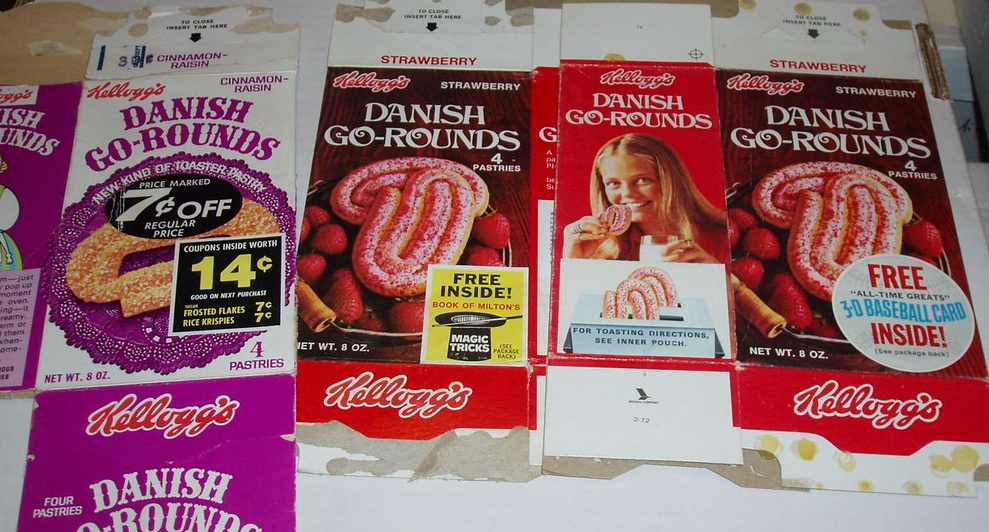
They didn’t really take off due to their tendency to fall apart in the packaging. In 1977, Go-Rounds were replaced by Danish Rings. Instead of the filling being tucked into the dough and then coiled, the shape was created by a stamp impressed into the oval pastry.
Deviled eggs
Sometimes known as salad eggs, eggs mimosa, and dressed eggs, deviled eggs have remained a staple appetizer at gatherings since Ancient Rome but they really had a moment in the 1970s. To “devil” meant to spice something up.
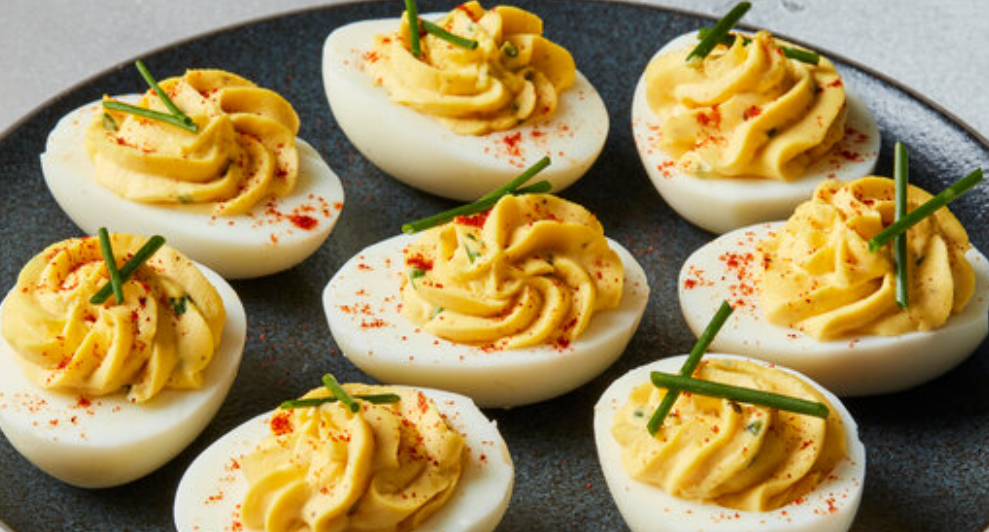
They were a sensation at cocktail parties in the 70s, helped along by the harvest gold deviled egg Tupperware container, which at the time was a must-have tool in any American kitchen. Deviled egg recipes in the US date back to 1896, however.
Wine and eggs
Probably the greatest entry on this list is the infamous wine and eggs diet promoted by Vogue magazine in 1978. Author Helen Gurley Brown advised women in search of weight loss to consume a bottle of wine a day as well as steak, eggs, and coffee.

Brown swore by this “diet” and so did a few other women of the era. Sadly, they were found out – and we really can’t believe this – to be wrong. Eating nothing but wine and eggs may sound fun but in practice, it lacks a lot of nutrition key to a healthy life.
Quiche
Sure, quiche existed before the 1970s and still exists today, but that was the decade that really put it on the map. This savoury French pastry dish is filled with meat or vegetables and baked into a solid body of eggs and milk, or a custard. Some people love it, others hate it.
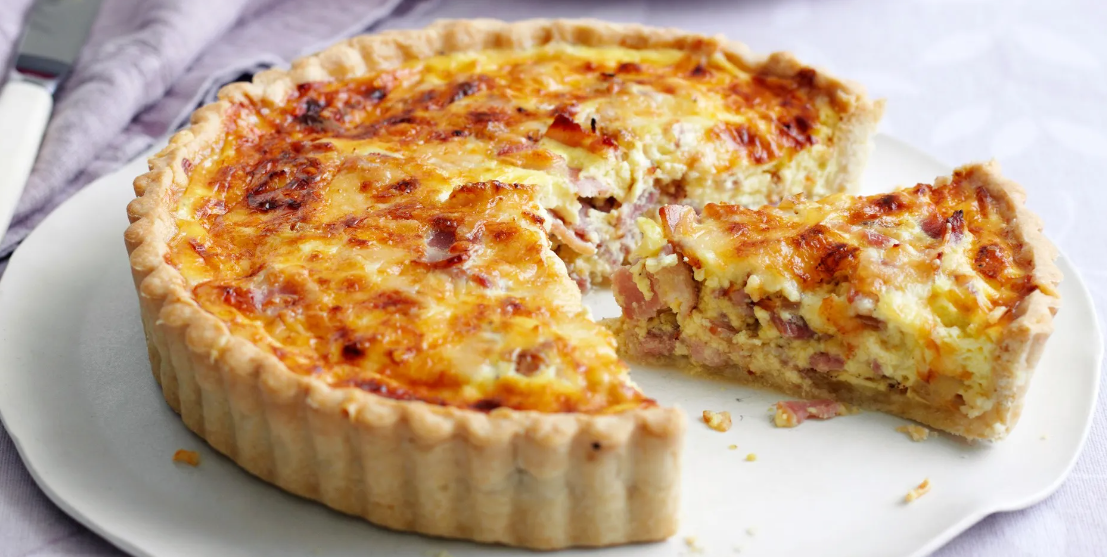
The sudden surge of interest in quiche in the 1970s is credited to an edition of The Joy of Cooking which featured a recipe. Others claim the influence of Julia Child helped Quiche hit the big time. Whatever the roots of it are, it was a staple of this decade.
Watergate Salad
You’re hearing that right. Watergate Salad was a sweet mix of canned pineapple, whipped cream, marshmallows, and Kraft’s pistachio pudding usually reserved for dessert. Back in the 1970s, this “salad” decided to go big when it really should have gone home.
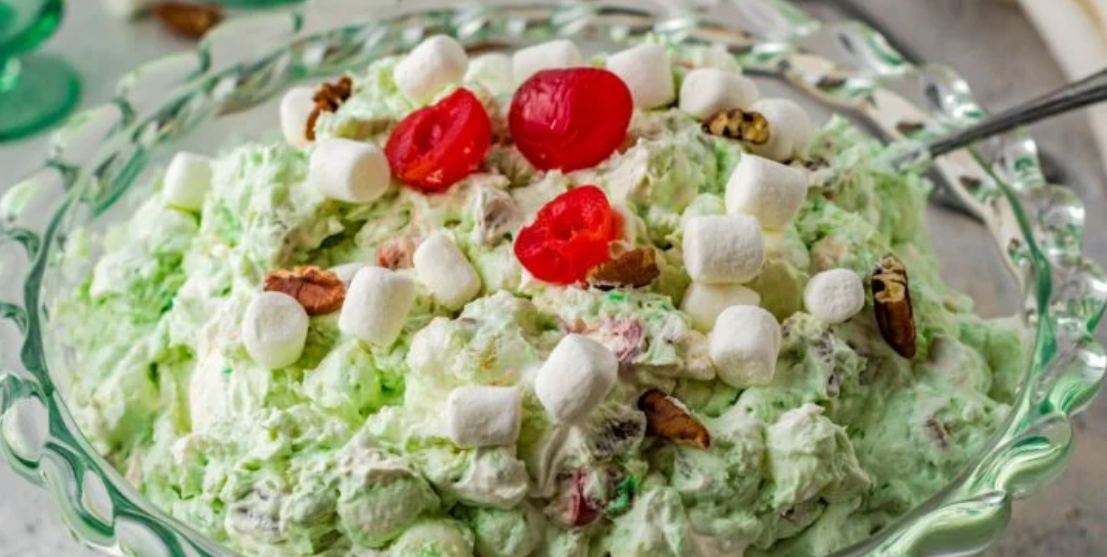
The origin of the dish or name has never been clear. Some believe it was named after a chef at the Watergate Hotel. Others believe its name was a nod to the Watergate scandal of 1973. Nobody really cared that much, so long as they could eat it by the trowel-load.